Selecting an appropriate site for municipal solid waste (MSW) disposal is a significant challenge in solid waste management (SWM) for local authorities, engineers, and urban planners. Rapid population growth, industrialization, diverse community characteristics, and limited land availability exacerbate this issue. Landfill site selection requires evaluating numerous factors, including environmental, social, and economic considerations, as well as adhering to various rules and spatial data. This paper presents an integrated approach using Geographic Information Systems (GIS) and the Analytical Hierarchy Process (AHP), based on Multi-Criteria Decision Analysis (MCDA), to select the most sustainable MSW disposal site in Kanchanpur district, Nepal. Criteria for site selection were derived from existing literature, including residential proximity, roads, water bodies, slopes, elevation, and national parks. GIS was used to develop criteria maps, and AHP was employed for pairwise comparison and normalization to assign weights to the criteria. The weighted overlay tool in ArcGIS was then used to evaluate the weighted criteria maps, categorizing the site suitability into five classes: “extremely suitable”, “considerably suitable”, “moderately suitable”, “slightly suitable”, and “restricted”. The suitability map identified the most suitable areas for waste disposal, with "extremely suitable" areas ideal for immediate use, and "considerably suitable" areas offering potential for future development. This method demonstrates the effectiveness of integrating GIS and AHP for sustainable solid waste management site selection in challenging environments like the Kanchanpur district.
| Published in | American Journal of Environmental Science and Engineering (Volume 9, Issue 1) |
| DOI | 10.11648/j.ajese.20250901.11 |
| Page(s) | 1-6 |
| Creative Commons |
This is an Open Access article, distributed under the terms of the Creative Commons Attribution 4.0 International License (http://creativecommons.org/licenses/by/4.0/), which permits unrestricted use, distribution and reproduction in any medium or format, provided the original work is properly cited. |
| Copyright |
Copyright © The Author(s), 2025. Published by Science Publishing Group |
Analytical Hierarchy Process (AHP), Bhimdatta Municipality, Geographic Information Systems (GIS), Kanchanpur, Multi Criteria Decision Analysis, Landfill Site


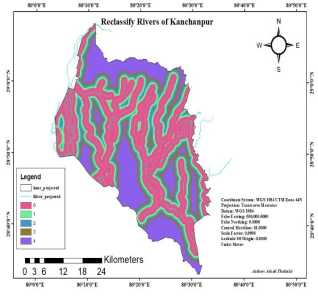
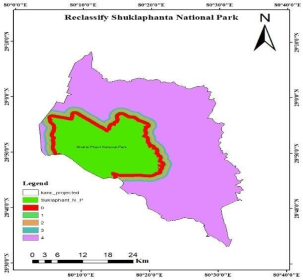
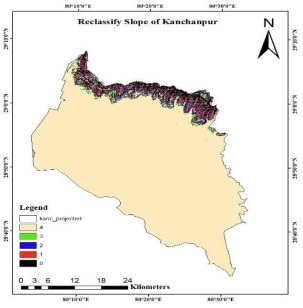
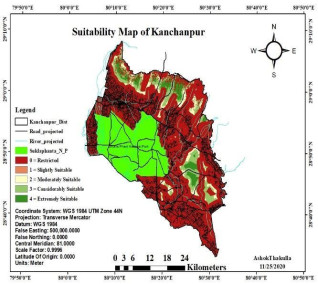
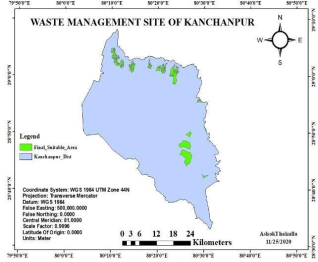
MSW | Municipal Solid Waste |
SWM | Solid Waste Management |
GIS | Geographic Information Systems |
AHP | Analytical Hierarchy Process |
MCDA | Multi-Criteria Decision Analysis |
RCRA | Resource Conservation and Recovery Act |
CBS | Central Bureau of Statistics |
DEM | Digital Elevation Model |
HDX | Humanitarian Data Exchange |
WMS | Waste Management Site |
| [1] | Olexa MT, Leviten A, Samek K. Florida Solid and Hazardous Waste Regulation Handbook: Solid and Hazardous Waste Disposal: FE457/FE457, 12/2003. EDIS 2004; 2004. |
| [2] | Joshi RP, Joshi YP. A Study on Solid Waste Composition in Kanchanpur District, Nepal. Health Prospect 2018; 17: 5–8. |
| [3] | Guerrero LA, Maas G, Hogland W. Solid waste management challenges for cities in developing countries. Waste Management 2013; 33: 220–32. |
| [4] | Sharholy M, Ahmad K, Mahmood G, Trivedi R. Municipal solid waste management in Indian cities – A review. Waste Management (New York, NY) 2008; 28: 459–67. |
| [5] | Bhowmick P, Das S, Das N. Identification of suitable sites for municipal waste dumping and disposal using multi-criteria decision-making technique and spatial technology: A case of Bolpur municipality, Birbhum district, West Bengal. Waste Management Bulletin 2024; 2: 250–65. |
| [6] | Greene R, Devillers R, Luther JE, Eddy BG. GIS-Based Multiple-Criteria Decision Analysis. Geography Compass 2011; 5: 412–32. |
| [7] | Dolui S, Sarkar S. Identifying potential landfill sites using multicriteria evaluation modeling and GIS techniques for Kharagpur city of West Bengal, India. Environmental Challenges 2021; 5: 100243. |
| [8] | Makonyo M, Msabi MM. Potential landfill sites selection using GIS-based multi-criteria decision analysis in Dodoma capital city, central Tanzania. GeoJournal 2022; 87: 2903–33. |
| [9] | Saaty RW. The analytic hierarchy process—what it is and how it is used. Mathematical Modelling 2021; 9: 161–76. |
| [10] | Siekelova A, Podhorska I, Imppola JJ. Analytic Hierarchy Process in Multiple–Criteria Decision–Making: A Model Example. SHS Web of Conf 2021; 90: 01019. |
| [11] | Pokhrel D, Viraraghavan T. Municipal solid waste management in Nepal: practices and challenges. Waste Management 2005; 25: 555–62. |
| [12] | Ferronato N, Torretta V. Waste Mismanagement in Developing Countries: A Review of Global Issues. International Journal of Environmental Research and Public Health 2019; 16: 1060. |
| [13] | Chandel AS, Weto AE, Bekele D. Geospatial technology for selecting suitable sites for solid waste disposal: a case study of Shone town, central Ethiopia. Urban, Planning and Transport Research 2024; 12: 2302531. |
| [14] | Dangi MB, Malla OB, Cohen RRH, Khatiwada NR, Budhathoki S. Life cycle assessment of municipal solid waste management in Kathmandu city, Nepal – An impact of an incomplete data set. Habitat International 2023; 139: 102895. |
| [15] | Sk MM, Ali SA, Ahmad A. Optimal Sanitary Landfill Site Selection for Solid Waste Disposal in Durgapur City Using Geographic Information System and Multi-criteria Evaluation Technique. KN J Cartogr Geogr Inf 2020; 70: 163–80. |
APA Style
Subedi, S., Thakulla, A., Joshi, Y., Ghimire, U. (2025). GIS Based MCDA Selection of Waste Management Site in Kanchanpur District, Nepal. American Journal of Environmental Science and Engineering, 9(1), 1-6. https://doi.org/10.11648/j.ajese.20250901.11
ACS Style
Subedi, S.; Thakulla, A.; Joshi, Y.; Ghimire, U. GIS Based MCDA Selection of Waste Management Site in Kanchanpur District, Nepal. Am. J. Environ. Sci. Eng. 2025, 9(1), 1-6. doi: 10.11648/j.ajese.20250901.11
@article{10.11648/j.ajese.20250901.11,
author = {Sushil Subedi and Ashok Thakulla and Yogesh Joshi and Uddav Ghimire},
title = {GIS Based MCDA Selection of Waste Management Site in Kanchanpur District, Nepal},
journal = {American Journal of Environmental Science and Engineering},
volume = {9},
number = {1},
pages = {1-6},
doi = {10.11648/j.ajese.20250901.11},
url = {https://doi.org/10.11648/j.ajese.20250901.11},
eprint = {https://article.sciencepublishinggroup.com/pdf/10.11648.j.ajese.20250901.11},
abstract = {Selecting an appropriate site for municipal solid waste (MSW) disposal is a significant challenge in solid waste management (SWM) for local authorities, engineers, and urban planners. Rapid population growth, industrialization, diverse community characteristics, and limited land availability exacerbate this issue. Landfill site selection requires evaluating numerous factors, including environmental, social, and economic considerations, as well as adhering to various rules and spatial data. This paper presents an integrated approach using Geographic Information Systems (GIS) and the Analytical Hierarchy Process (AHP), based on Multi-Criteria Decision Analysis (MCDA), to select the most sustainable MSW disposal site in Kanchanpur district, Nepal. Criteria for site selection were derived from existing literature, including residential proximity, roads, water bodies, slopes, elevation, and national parks. GIS was used to develop criteria maps, and AHP was employed for pairwise comparison and normalization to assign weights to the criteria. The weighted overlay tool in ArcGIS was then used to evaluate the weighted criteria maps, categorizing the site suitability into five classes: “extremely suitable”, “considerably suitable”, “moderately suitable”, “slightly suitable”, and “restricted”. The suitability map identified the most suitable areas for waste disposal, with "extremely suitable" areas ideal for immediate use, and "considerably suitable" areas offering potential for future development. This method demonstrates the effectiveness of integrating GIS and AHP for sustainable solid waste management site selection in challenging environments like the Kanchanpur district.},
year = {2025}
}
TY - JOUR T1 - GIS Based MCDA Selection of Waste Management Site in Kanchanpur District, Nepal AU - Sushil Subedi AU - Ashok Thakulla AU - Yogesh Joshi AU - Uddav Ghimire Y1 - 2025/01/14 PY - 2025 N1 - https://doi.org/10.11648/j.ajese.20250901.11 DO - 10.11648/j.ajese.20250901.11 T2 - American Journal of Environmental Science and Engineering JF - American Journal of Environmental Science and Engineering JO - American Journal of Environmental Science and Engineering SP - 1 EP - 6 PB - Science Publishing Group SN - 2578-7993 UR - https://doi.org/10.11648/j.ajese.20250901.11 AB - Selecting an appropriate site for municipal solid waste (MSW) disposal is a significant challenge in solid waste management (SWM) for local authorities, engineers, and urban planners. Rapid population growth, industrialization, diverse community characteristics, and limited land availability exacerbate this issue. Landfill site selection requires evaluating numerous factors, including environmental, social, and economic considerations, as well as adhering to various rules and spatial data. This paper presents an integrated approach using Geographic Information Systems (GIS) and the Analytical Hierarchy Process (AHP), based on Multi-Criteria Decision Analysis (MCDA), to select the most sustainable MSW disposal site in Kanchanpur district, Nepal. Criteria for site selection were derived from existing literature, including residential proximity, roads, water bodies, slopes, elevation, and national parks. GIS was used to develop criteria maps, and AHP was employed for pairwise comparison and normalization to assign weights to the criteria. The weighted overlay tool in ArcGIS was then used to evaluate the weighted criteria maps, categorizing the site suitability into five classes: “extremely suitable”, “considerably suitable”, “moderately suitable”, “slightly suitable”, and “restricted”. The suitability map identified the most suitable areas for waste disposal, with "extremely suitable" areas ideal for immediate use, and "considerably suitable" areas offering potential for future development. This method demonstrates the effectiveness of integrating GIS and AHP for sustainable solid waste management site selection in challenging environments like the Kanchanpur district. VL - 9 IS - 1 ER -